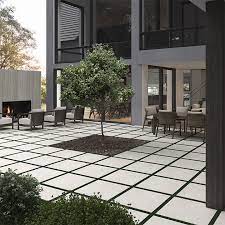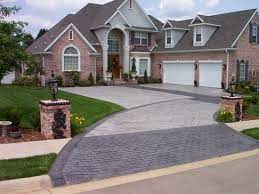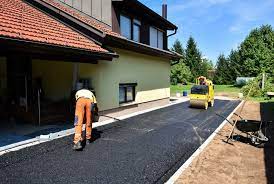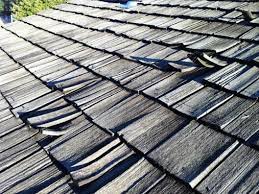Paver Art: Masterful Installations That Redefine Landscaping
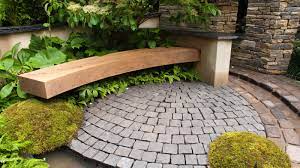
From simple gardens and lawns, landscaping has evolved into breathtaking works of art. Pavers, once viewed as merely functional elements, have become the canvas for breathtaking landscape design masterpieces. Paver art is a creative and innovative landscaping technique that transforms outdoor spaces into captivating works of art. This blog will explore the fascinating world of paver art, the techniques used to create these masterful installations, and the limitless opportunities they offer to enhance the aesthetics of any outdoor space.
1. From Functionality to Creativity:
Historically, pavers were primarily employed for utilitarian purposes, such as constructing walkways, driveways, and patios. However, visionary landscape architects have pushed the limits of paver applications, allowing them to craft exquisite installations. Paver art combines form and function, providing both practical utility and artistic expression that captivates the eye and stirs the spirit.
2. The Role of Paver Shapes and Colors:
The use of various paver shapes and colors is one of the most important aspects of paver art. Modern pavers are available in a vast array of styles, ranging from traditional bricks to hexagons, diamonds, and atypical patterns. By skillfully combining various forms and hues, designers are able to create mesmerizing and intricate patterns that transform the ground into a living canvas.
3. The Geometry of Symmetry and Harmony:
Geometric patterns are popular in paver art because they convey a sense of symmetry and balance. Intricate mosaics, herringbone patterns, and chevron patterns are a few examples of geometric paver art that adds sophistication and elegance to any landscape. These visually arresting designs function as focal points, drawing the eye and establishing order among the surrounding natural elements.
4. Paver Art Inspired by Nature:
Nature has always been a rich source of inspiration for artists and architects. In paver art, designers are frequently inspired by the organic patterns found in nature. With pavers, a touch of nature’s beauty can be added to the landscape by recreating leaf motifs, floral patterns, and flowing water designs. Not only do these installations blend seamlessly with their surroundings, but they also celebrate the splendor of the great outdoors.
5. Transformative Power of Paver Art:
Paver murals and custom artwork offer limitless possibilities for those seeking truly unique and personalized installations. Skilled artisans are capable of transforming ordinary pavers into mesmerizing murals depicting scenes from nature, abstract art, or even historical figures. Custom paver art enables homeowners to imbue their outdoor space with their personality and interests, thereby making it a true reflection of their individuality.
6. Paver Art and Public Spaces:
Paver art is not restricted to private gardens and residential areas; it thrives in public spaces and urban settings as well. Large-scale paver art installations have transformed cityscapes, plazas, and public parks into canvases. Not only do these public works of art beautify the environment, but they also enrich the cultural experience of visitors and locals.
7. Power of Paver Art to Transform:
Paver art has the remarkable ability to transform any outdoor space, transforming mundane areas into extraordinary displays. A plain courtyard can be transformed into an enchanting oasis, a plain sidewalk into an artistic promenade, and a dull patio into a lively entertainment space. The transformative power of paver art permits limitless creativity, thereby enhancing the quality of life and instilling awe in those who view these works of art.
8. The Technical Expertise Behind Paver Art:
While paver art may appear effortless and whimsical, the creation of these masterful installations requires technical expertise and precision of paver installation services. Landscape architects and skilled laborers collaborate to ensure that each paver is precisely positioned to achieve the desired design. Advanced tools and cutting-edge techniques are used to create flawless patterns and preserve the installation’s integrity.
9. Sustainable Paver Art:
In the pursuit of eco-friendly design, sustainable paver art has become popular. Using eco-friendly materials and permeable pavers, designers can create aesthetically pleasing installations that contribute to sustainable water management. These installations permit rainwater to permeate the soil, thereby recharging groundwater and decreasing stormwater runoff.
10. Enhancing Property Value and Appeal:
Paver art not only improves a property’s aesthetics, but also significantly increases its value. A professionally designed and executed paver art installation can be a major selling point for homeowners, distinguishing their property from others on the market. The artistic and one-of-a-kind appeal of paver art can also attract buyers seeking a one-of-a-kind outdoor living environment.
Conclusion:
Paver art has redefined the limits of landscaping, transforming outdoor spaces into masterful installations that inspire awe and awe-inspiring delight. From geometric patterns to designs inspired by nature, paver art demonstrates the creative ingenuity of landscape architects and the technical mastery of skilled artisans. Not only do these breathtaking installations enhance the aesthetics of a property, but they also improve the quality of life for those who experience them. As we continue to push the boundaries of landscape design creativity, paver art stands as a testament to the enduring fusion of artistry and functionality in the world of landscaping. Let us embrace the artistic potential of paver installations, transforming ordinary spaces into extraordinary works of art that will revolutionize the landscape architecture industry, find more here.


